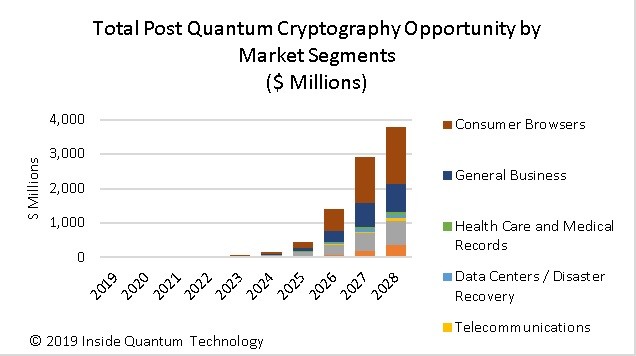On IBM Quantum Tape Drive – Perfect Place for Start Integrating PQC?
The Post Quantum Cryptography (PQC) market is one of few real world markets the industry analyst’s much used hockey stick curve actually makes much sense. As quantum computers capable of breaking popular encryption codes get nearer and nearer users will become more prone to deploying PQC and that kind of consumer behavior necessitates exponential growth. Opinions differ on whether the apocalyptic day, when decades of standard encryption will be rendered pointless will happen in five, ten or twenty years. However, whenever it arrives the growth pattern will have that characteristic hockey stick look to it.
Here is our version of the of PQC hockey taken from our current report on the PQC: Post-Quantum Cryptography: A Ten-Year Market and Technology Forecast https://www.insidequantumtechnology.com/product/post-quantum-cryptography-ten-year-forecast/

PQC deployment presumably will eventually be embodied the most common software platforms – browsers for example – as quantum computing technology evolves. But until that happens, expect to see PQC (chips or software) on drives of some sort. As the Exhibit below suggests, with today’s conventional wisdom that it will be ten years before quantum computers are powerful enough to threaten data, only very long-lived data needs to be protected now.

Source: Inside Quantum Technology
This seems to mean that PQC will appear on Magnetic drives first and IBM has recently recognized this with its announcement of a “Quantum Computing Safe Tape Drive”. This tape drive has PQC integrated into its firmware, protecting data with algorithms based on lattice cryptography. While none of the PQC algorithms have been proved to withstand all potential attacks based on brute-force computational power, this solution is a good start. Firmware solutions are always easier to implement, and the specific algorithm used has passed into the second round of qualifications by NIST, making it more reliable.
Flash drives and HDDs are widespread, but they have relatively short shelf lives, and unless there are some breakthroughs in quantum computing, we don’t expect them to have embedded PQC for at least another five years. The data stored on them tends to drop off in sensitivity rather quickly. Tapes, on the other hand, boast storage capacities of 100s of GB per square inch, adding up to 10s of TB per tape. Due to magnetic tapes lasting tens of years and surviving a wide range of atmospheric conditions, IT companies actively use them for backups. Hacking such an archive in the future could reveal the entire history of a company, which could spell disaster for multiple reasons. So PQC has obvious advantages.
The leaders in magnetic tape production and those pushing the limits of the technology are IBM, Sony, and Fujifilm. IBM, as we all know, is already actively involved in the race for quantum computer supremacy, making it a logical candidate to spread this experience into quantum cybersecurity. It has been known for quite some time that IBM was was working with PQC, but what it was doing with PQC was not really known. Now it is.
If you want to learn the latest informations on PQC attend our conference, IQT-Europe in the Netherlands on October 29-30. For more details see https://europe2019.iqtevent.com. Among other topics, the conference will feature several sessions on quantum cybersecurity – both PQC and QKD.















